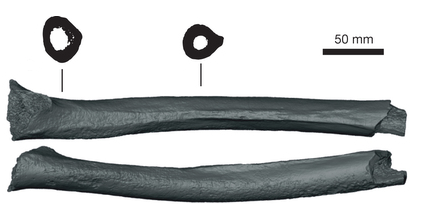Modern humans evolved in Africa around 195,000 years ago, but soon spread across the world. However, we weren’t the first species of human to leave Africa and we encountered other members of the human family on the way (like the Neanderthals). How we interacted with these other hominins is a fascinating topic. Did we trade and learn from each other? Did we fight? And it turns out we interbred with them; but that just raises a whole host of new questions. When? Where? How often?
DNA was recently recovered from a 45,000 year old human femur in Siberia (making it one of the oldest sources of modern human DNA ever); which may shed light on some of these questions1. In particular, how frequently were humans and Neanderthals actually interbreeding? Previous studies had estimated that the Neanderthal DNA in our genome could be explained by only a few dozen interbreeding events2; but this is really only a minimum figure. There could’ve been a lot more; with all that extra Neanderthal DNA being lost/diluted in the intervening tens of thousands of years.

The super-informative femur.
So how much interbreeding was actually going on? I shan’t keep you in suspense: the Siberian femur confirms that there wasn’t actually that much interbreeding, containing a similar amount of Neanderthal DNA as modern Europeans. It would seem humans and Neanderthals studied each others biology (if you catch my drift) only a handful of times1. Neanderthals were not peacefully amalgamated into Homo sapiens. They almost all died. Sad times.
Whilst that’s the headline discovery from this really old genome the revelations don’t end there. So hold on to your DNA for a whirlwind tour of the other interesting things this femur has revealed.
First fun finding is that the amount of Neanderthal DNA in the Siberian femur is very similar to that of modern non-Africans (around 2 – 4%). 45,000 years of mutations, reproduction and demographic shenanigans hasn’t really altered it1. This strongly implies that we may now be reliant upon some of that Neanderthal DNA to survive; so it can’t be tampered with. On the other hand, despite living much closer to the interbreeding event a lot of Neanderthal DNA has already been lost in the Siberian; suggesting much of it may have been downright harmful and so natural selection quickly eliminated it.
Speaking of living closer to the interbreeding event, here’s the second fun finding. Sexual reproduction muddles up your genes and as a result of this our Neanderthal DNA has been spread throughout our genome; whilst most of that DNA in the Siberian femur is still clumped together. The researchers were able to use these differences to estimate when the interbreeding even actually occurred. Apparently we got funky with the Neanderthals ~60,000 years ago1. This is particularly interesting given we may have already met Neanderthals by 80,000 years ago3. Clearly it took a long time for early humans to come up with a good enough chat-up line to interest the Neanderthals.

The genomes of several people laid out next to each other. Yellow bits represent Neanderthal DNA. The Siberian femur is the top one, with the others being more modern individuals.
Moving swiftly on, the third fun finding is that the Siberian is more closely related to modern non-Africans than modern Africans. This would imply that modern non-Africans are descended from any subsequent migrations out of Africa. Those early pioneers who spread out of Africa is the same group modern non-Africans are descended from1. This probably isn’t a hugely significant in terms of human evolution; but as one of those descendants I find it really cool knowing all that amazing cave art might be part of my direct heritage.
And the final fun fact: This very informative Siberian was male1.
In short, a group of humans left Africa. Out in the wide world they encountered the Neanderthals; and after a little while getting comfortable interbred with them on a few rare occasions. This gave them a lot of genes that may have been harmful, but some which may have helped them survive. And survive they did, lasting all the way to the present day.
References
- Qiaomei Fu et al. 2014. Genome sequence of a 45,000-year-old modern human from western Siberia. Nature.
- Neves, A. G., & Serva, M. (2012). Extremely rare interbreeding events can explain neanderthal dna in living humans. PloS one, 7(10), e47076.
- Stringer, C. B., Grün, R., Schwarcz, H. P., & Goldberg, P. (1989). ESR dates for the hominid burial site of Es Skhul in Israel. Nature, 338(6218), 756-758.

